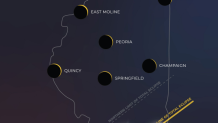If it's cloudy in the Chicago area during Monday's total solar eclipse, will you still be able to see it?
The short answer is....maybe. The longer answer takes some explaining.
Recent forecast projections indicate cloudy conditions could be in store for the rare celestial event, marking an already welcomed shift from forecast predictions earlier this week, but it could still alter what you see in the sky.
The forecast continues to change in the lead-up to the event.
According to the latest prediction from the National Weather Service, conditions appear to have cleared up for some parts of Illinois and Indiana, despite earlier potential for severe storms, but cloudy conditions linger for parts of northern Illinois and the Chicago area. Still, the NWS urges people to check back and "expect the forecast to change."
If rain holds off and only clouds remain, the visibility for the eclipse could depend on the type of clouds that appear.
"Even 100% cloud cover, it could be thin clouds and you still may see at least a filtered view of the solar eclipse," NBC 5 Meteorologist Kevin Jeanes said. "So just because you see a lot of clouds on a computer model it doesn't mean you're not going to be able to see anything."
"If you have high thin clouds, it can block the view slightly but will still allow for much of the eclipse to be visible," Meteorologist Alicia Roman said. "If you have low, thick clouds ... it will still look darker for the duration of the eclipse, it just wont be as dramatic as if it were a sunny day and turning completely dark the next second. The skies will just dim or get a little darker."
Jeanes noted the models Thursday showed the average cloud cover around 45% in Chicago and 26% Indianapolis, "which is one of the lower percentages if you look across the path of totality."
Feeling out of the loop? We'll catch you up on the Chicago news you need to know. Sign up for the weekly Chicago Catch-Up newsletter.
"I think the more concerning area for cloud cover is going to be actually farther south across Texas and Arkansas and those are areas," Jeanes said.
When a solar eclipse happens, some clouds tend to disappear.
Scientists at the Royal Netherland Meteorological Institute recently found shallow cumulus clouds dissipate in large number when just 15% of the sun is covered. That’s because the earth’s surface cools when the sunlight is blocked, reducing updrafts of warm air that usuaully emanate. Those updrafts are necessary to form cumulus clouds since they carry water vapor as they rise into cooler altitutdes.
What time is the solar eclipse?
According to NASA scientists, the eclipse will take place on Monday, April 8 in the afternoon hours across the North American continent, with the area of totality impacting areas in southern Illinois and central Indiana.
During a total solar eclipse, the new moon intersects the path of the sun in the sky, causing the sun to be partially and then nearly completely blocked from view.
In Carbondale, Illinois, the partial eclipse on April 8 will begin at approximately 12:42 p.m. During this time, special glasses will be needed to view the eclipse, though there are other ways of seeing the moon’s impact on the sun’s light reaching the Earth.
At approximately 1:59 p.m., “totality” will begin in Carbondale, and during this time, stargazers will be able to look at the eclipse without any aid whatsoever, with darkened skies and the famed “corona” blazing around the edges of the moon.
This period will not last for very long, as totality is expected to end at approximately 2:03 p.m., according to NASA scientists.
The partial eclipse will continue for another hour, ending at approximately 3:18 p.m.
Where is the "path of totality?"
The eclipse's "path of totality" will start in Southwest Texas and move northeast.
The path of totality includes the southern tip of Illinois, central and southern Indiana and Indianapolis. From there, it will race across Cleveland, Ohio; Buffalo, New York and into Maine.
The below map from the Adler Planetarium shows what the eclipse will look like in Illinois, with Carbondale, Mount Vernon, Metropolis and Mount Carmel among the southern Illinois cities in the path of totality.


